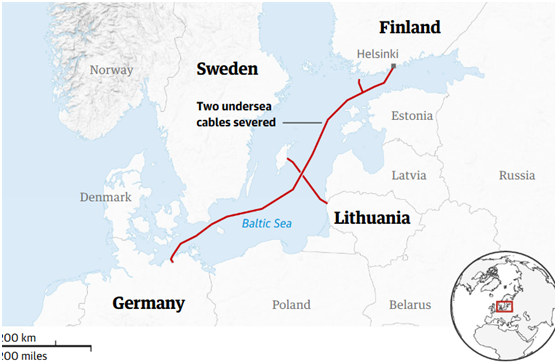

Hotline

Undersea Communication Network Resilience Tested Amid Baltic Cable Disruption
Portsmouth / Helsinki—August 25, 2025 — Recent disruptions to key undersea telecommunication cables in the Baltic Sea have spotlighted both the fragility of global connectivity infrastructure and the need for enhanced vigilance in safeguarding critical networks.
In mid-November 2024, two major submarine data lines—one linking Lithuania to Sweden and another connecting Finland to Germany—suffered simultaneous cable failures, triggering major concerns across Northern Europe. Preliminary investigations suggest these incidents may have been caused by the dragging of a ship’s anchor across the seabed, cutting through both cables and severing vital communication lanes
National authorities responded rapidly. The Swedish Prosecution Authority initiated a criminal investigation into suspected sabotage, while the Finnish National Bureau of Investigation opened a parallel inquiry under suspicions of aggravated interference with communications
. Meanwhile, Germany and Finland jointly issued statements expressing deep concern and weighing the possibility of hybrid warfare tactics aimed at disrupting critical infrastructure
The vessel under scrutiny, a bulk carrier whose presence in the affected area coincided with the disruptions, reportedly had its automatic identification system (AIS) disabled during the period in question. Observers later reported anchor damage consistent with having sliced across seabed infrastructure
. Tensions rose as naval forces from Sweden, Denmark, and Germany kept watch over the anchored ship, while diplomatic channels negotiated observer access during the ongoing probe
These back-to-back outages underscore the vulnerability of underwater communication routes—over 99% of international data traffic passes through subsea cables. Even minor disturbances can trigger widespread regional and global repercussions. Experts argue that ensuring redundancy in cable routing and enhancing monitoring around critical maritime zones are essential to bolster resilience
.
As investigations continue, stakeholders across the region advocate for stronger legal frameworks, increased coordination among allied nations, and advances in real-time cable-monitoring technologies to prevent future incidents. The cable operators affected, as well as international authorities overseeing oceanic infrastructure, remain on high alert while pursuing both technical remedies and diplomatic resolutions.


Undersea Communication Network Resilience Tested Amid Baltic Cable Disruption
Portsmouth / Helsinki—August 25, 2025 — Recent disruptions to key undersea telecommunication cables in the Baltic Sea have spotlighted both the fragility of global connectivity infrastructure and the need for enhanced vigilance in safeguarding critical networks.
In mid-November 2024, two major submarine data lines—one linking Lithuania to Sweden and another connecting Finland to Germany—suffered simultaneous cable failures, triggering major concerns across Northern Europe. Preliminary investigations suggest these incidents may have been caused by the dragging of a ship’s anchor across the seabed, cutting through both cables and severing vital communication lanes
National authorities responded rapidly. The Swedish Prosecution Authority initiated a criminal investigation into suspected sabotage, while the Finnish National Bureau of Investigation opened a parallel inquiry under suspicions of aggravated interference with communications
. Meanwhile, Germany and Finland jointly issued statements expressing deep concern and weighing the possibility of hybrid warfare tactics aimed at disrupting critical infrastructure
The vessel under scrutiny, a bulk carrier whose presence in the affected area coincided with the disruptions, reportedly had its automatic identification system (AIS) disabled during the period in question. Observers later reported anchor damage consistent with having sliced across seabed infrastructure
. Tensions rose as naval forces from Sweden, Denmark, and Germany kept watch over the anchored ship, while diplomatic channels negotiated observer access during the ongoing probe
These back-to-back outages underscore the vulnerability of underwater communication routes—over 99% of international data traffic passes through subsea cables. Even minor disturbances can trigger widespread regional and global repercussions. Experts argue that ensuring redundancy in cable routing and enhancing monitoring around critical maritime zones are essential to bolster resilience
.
As investigations continue, stakeholders across the region advocate for stronger legal frameworks, increased coordination among allied nations, and advances in real-time cable-monitoring technologies to prevent future incidents. The cable operators affected, as well as international authorities overseeing oceanic infrastructure, remain on high alert while pursuing both technical remedies and diplomatic resolutions.


电话:4006228811
邮箱:longcai@126.com
传真:400-681-8888
地址:哈尔滨市道里区爱建路13号


